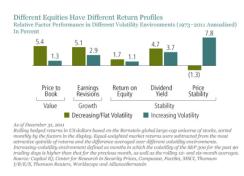During the market crisis of 2008–2011, traditional equity style strategies such as value and growth underperformed the markets, often by wide margins. But our research shows that there was a way to diminish the negative impact of market turmoil on portfolio returns.
In a recent study, we found that in volatile markets, stocks performed relatively well if they had at least one of the following characteristics:
• Fundamental stability (consistent cash flows and lower earnings volatility)
• Price stability (less volatile stock prices)
• Market stability (less exposure to directional equity-market moves, or lower beta)
Our study sought to understand how different types of stocks behave under different conditions. We divided the market environment into two distinct types: periods of increasing volatility and periods of decreasing or stable volatility. Then we looked at how value stocks (those with low price/book value), growth stocks (those with high earnings revisions) and stability stocks (those with high fundamental stability, price stability or market stability) performed in both types of environments.
We found that when market volatility was falling or flat, value and growth stocks performed best and outperformed a global universe of stocks by a healthy margin. When volatility was rising, however, results for value and growth stocks were much weaker (Display).

During these volatile periods, stocks with high return on equity, high dividend yields and price stability did best.
These patterns were even more pronounced from 2001 through 2011, when market volatility was high in 25 percent of all months. Once again, value and growth stocks performed well when volatility was low or falling, but lagged when turbulence was high. During the periods of high volatility, stocks with high return on equity and high dividend yields did well, and stocks with better price stability (lower volatility) performed best, beating equity markets by 10.8 percent a year on average.
We believe that stocks with fundamental or price stability did well in difficult market environments because fearful investors preferred the security of dividends and stable prices in tough times. Such stocks also play out over a much shorter time horizon than value or growth stocks.
We think the traditional framework of investing by style and market capitalization is evolving toward an enhanced paradigm in which investors place more emphasis than they have historically on absolute risk and benchmark sensitivity when choosing their equity strategies.
These findings show that focusing on risk management doesn’t have to mean sacrificing return. Investors can find less risky stocks with solid return potential. In other words, the risk anomaly that has been long overlooked can now be exploited to generate better risk-adjusted returns over time.
We still think traditional value and growth strategies remain valuable because they have worked well for extended periods of time. But keeping part of an allocation in stability equities should provide useful protection from heightened market volatility during periods when value and growth are challenged,
The views expressed herein do not constitute research, investment advice or trade recommendations and do not necessarily represent the views of all AllianceBernstein portfolio-management teams.
Sharon Fay is Head of Equities at AllianceBernstein.





